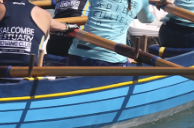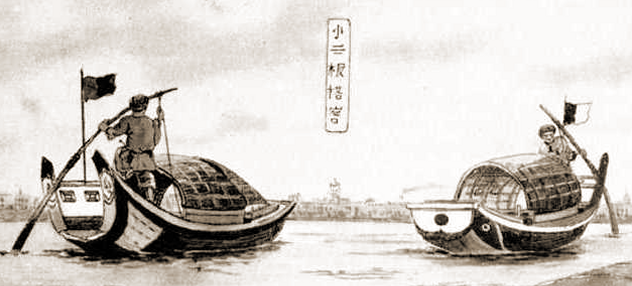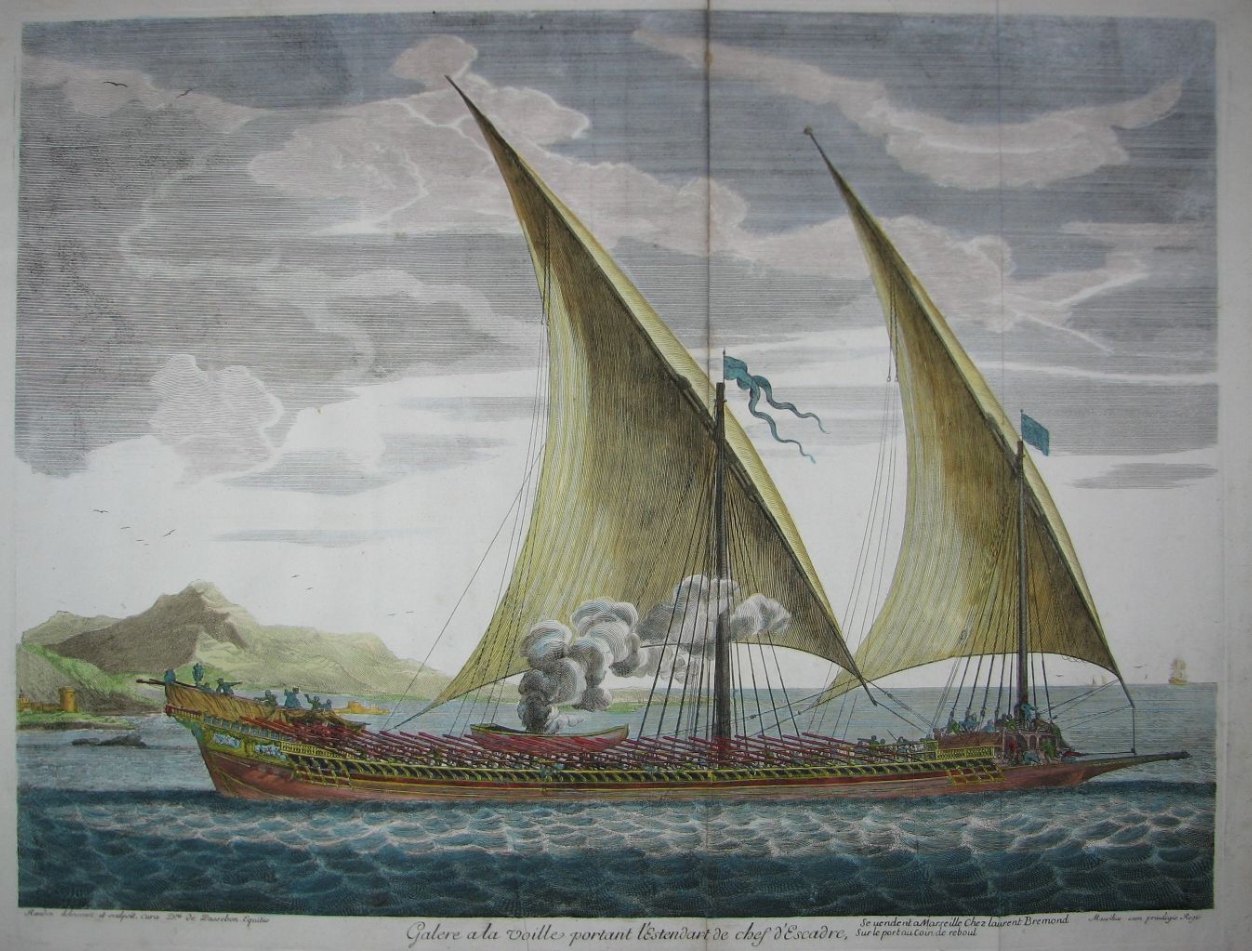|
Rowing
Rowing is the act of propelling a human-powered watercraft using the sweeping motions of oars to displace water and generate reactional propulsion. Rowing is functionally similar to paddling, but rowing requires oars to be mechanically attached to the boat, and the rower drives the oar like a lever, exerting force in the ''same'' direction as the boat's travel; while paddles are completely hand-held and have no attachment to the boat, and are driven like a cantilever, exerting force ''opposite'' to the intended direction of the boat. In some strict terminologies, using oars for propulsion may be termed either "pulling" or "rowing", with different definitions for each. Where these strict terminologies are used, the definitions are reversed depending on the context. On saltwater a "pulling boat" has each person working one oar on one side, alternating port and starboard along the length of the boat; whilst "rowing" means each person operates two oars, one on each side of ... [...More Info...] [...Related Items...] OR: [Wikipedia] [Google] [Baidu] |
Competitive Rowing
Rowing, often called crew in the United States, is the sport of racing boats using oars. It differs from paddling sports in that rowing oars (called blades in the United Kingdom) are attached to the boat using rowlocks, while paddles are not connected to the boat. Rowing is divided into two disciplines: sculling and sweep rowing. In sculling, each rower (or oarsman) holds two oars, one in each hand, while in sweep rowing each rower holds one oar with both hands. There are several boat classes in which athletes may compete, ranging from single sculls, occupied by one person, to shells with eight rowers and a coxswain, called eights. There are a wide variety of course types and formats of racing, but most elite and championship level racing is conducted on calm water courses long with several lanes marked using buoys. Modern rowing as a competitive sport can be traced to the early 17th century when professional watermen held races (regattas) on the River Thames in London ... [...More Info...] [...Related Items...] OR: [Wikipedia] [Google] [Baidu] |
Sport Rowing
Rowing, often called crew in the United States, is the sport of racing boats using oars. It differs from paddling sports in that rowing oars (called blades in the United Kingdom) are attached to the boat using rowlocks, while paddles are not connected to the boat. Rowing is divided into two disciplines: sculling and sweep rowing. In sculling, each rower (or oarsman) holds two oars, one in each hand, while in sweep rowing each rower holds one oar with both hands. There are several boat classes in which athletes may compete, ranging from single sculls, occupied by one person, to shells with eight rowers and a coxswain, called eights. There are a wide variety of course types and formats of racing, but most elite and championship level racing is conducted on calm water courses long with several lanes marked using buoys. Modern rowing as a competitive sport can be traced to the early 17th century when professional watermen held races ( regattas) on the River Thames in Lon ... [...More Info...] [...Related Items...] OR: [Wikipedia] [Google] [Baidu] |
Boat Racing
Boat racing is a sport in which boats, or other types of watercraft, race on water body, water. Boat racing powered by oars is recorded as having occurred in ancient Egypt, and it is likely that people have engaged in races involving boats and other water-borne craft for as long as such watercraft have existed. A regatta is a series of boat races. The term comes from the Venetian language, with ''regata'' meaning "contest, contention for mastery"(from ''regatare'' ("compete, haggle, sell at retail"), possibly from ''recatare'') and typically describes racing events of Rowing (sport), rowed or Sailing (sport), sailed water craft, although some powerboat race series are also called regattas. A regatta often includes social and promotional activities which surround the racing event, and except in the case of boat type (or "class") championships, is usually named for the town or venue where the event takes place; for example “valley field”. Although regattas are typically amate ... [...More Info...] [...Related Items...] OR: [Wikipedia] [Google] [Baidu] |
Rowing 305598
Rowing is the act of propelling a human-powered watercraft using the sweeping motions of oars to displace water and generate reactional propulsion. Rowing is functionally similar to paddling, but rowing requires oars to be mechanically attached to the boat, and the rower drives the oar like a lever, exerting force in the ''same'' direction as the boat's travel; while paddles are completely hand-held and have no attachment to the boat, and are driven like a cantilever, exerting force ''opposite'' to the intended direction of the boat. In some strict terminologies, using oars for propulsion may be termed either "pulling" or "rowing", with different definitions for each. Where these strict terminologies are used, the definitions are reversed depending on the context. On saltwater a "pulling boat" has each person working one oar on one side, alternating port and starboard along the length of the boat; whilst "rowing" means each person operates two oars, one on each side of the ... [...More Info...] [...Related Items...] OR: [Wikipedia] [Google] [Baidu] |
Stern Sculling
Stern sculling is the use of a single oar over the stern of a boat to propel it with side-to-side motions that create forward lift in the water. The strict terminology of propulsion by oar is complex and contradictory, and varies by context. Stern sculling may also simply be referred to as "sculling", most commonly so in a maritime situation. In fresh water, and particularly in sport rowing, sculling is use of two oars on either side of the boat by each person, in contrast to sweep rowing, whereby each boat crew member employs a single oar, complemented by another crew member working on the opposite side with their oar. Overview Stern sculling is the process of propelling a watercraft by moving a single, stern-mounted oar from side to side while changing the angle of the blade so as to generate forward thrust on both strokes. The technique is very old and its origin uncertain, though it is thought to have developed independently in different locations and times. It is known to h ... [...More Info...] [...Related Items...] OR: [Wikipedia] [Google] [Baidu] |
Human-powered Watercraft
Human-powered watercraft are watercraft propelled only by human power, instead of being propelled by wind power (via one or more sails) or an engine. The three main methods of exerting human power are: # directly from the hands or feet, sometimes aided by swimfins; # through hand-operated oars, paddles, or poles, or; # through the feet with pedals, crankset or treadle. While most human-powered watercraft use buoyancy to maintain their position relative to the surface of the water, a few, such as human-powered hydrofoils and human-powered submarines, use hydrofoils, either alone or in addition to buoyancy. Oared craft Oars are held at one end, have a blade on the other end, and pivot in between in oarlocks. Oared craft include: * Racing shell Using oars in pairs, with one hand on each oar, is two-oar sculling. The oars may also be called sculls. Two-oared sculled craft include: * Adirondack guideboat * Banks dory, Gloucester dory, and McKenzie River dory * Din ... [...More Info...] [...Related Items...] OR: [Wikipedia] [Google] [Baidu] |
Galley
A galley is a type of ship optimised for propulsion by oars. Galleys were historically used for naval warfare, warfare, Maritime transport, trade, and piracy mostly in the seas surrounding Europe. It developed in the Mediterranean world during Classical antiquity, antiquity and continued to exist in various forms until the early 19th century. It typically had a long, slender hull, shallow draft (hull), draft, and often a low freeboard (nautical), freeboard. Most types of galleys also had sails that could be used in favourable winds, but they relied primarily on oars to move independently of winds and currents or in battle. The term "galley" originated from a Greek term for a small type of galley and came in use in English from about 1300. It has occasionally been used for unrelated vessels with similar military functions as galley but which were not Mediterranean in origin, such as medieval Scandinavian longships, 16th-century Ghali (ship), Acehnese ghalis and 18th-century North ... [...More Info...] [...Related Items...] OR: [Wikipedia] [Google] [Baidu] |
Woman Rowing Sampan With Her Feet In Ninh Bình Province Of Northern Vietnam
A woman is an adult female human. Before adulthood, a female child or adolescent is referred to as a girl. Typically, women are of the female sex and inherit a pair of X chromosomes, one from each parent, and women with functional uteruses are capable of pregnancy and giving birth from puberty until menopause. More generally, sex differentiation of the female fetus is governed by the lack of a present, or functioning, '' SRY'' gene on either one of the respective sex chromosomes. Female anatomy is distinguished from male anatomy by the female reproductive system, which includes the ovaries, fallopian tubes, uterus, vagina, and vulva. An adult woman generally has a wider pelvis, broader hips, and larger breasts than an adult man. These characteristics facilitate childbirth and breastfeeding. Women typically have less facial and other body hair, have a higher body fat composition, and are on average shorter and less muscular than men. Throughout human history, traditional g ... [...More Info...] [...Related Items...] OR: [Wikipedia] [Google] [Baidu] |
Steamboat
A steamboat is a boat that is marine propulsion, propelled primarily by marine steam engine, steam power, typically driving propellers or Paddle steamer, paddlewheels. The term ''steamboat'' is used to refer to small steam-powered vessels working on lakes, rivers, and in short-sea shipping. The development of the steamboat led to the larger steamship, which is a seaworthy and often ocean-going ship. Steamboats sometimes use the ship prefix, prefix designation SS, S.S. or S/S (for 'Screw Steamer') or PS (for 'Paddle Steamer'); however, these designations are most often used for steamships. Background Limitations of the Newcomen steam engine The first steamboat designs used Newcomen atmospheric engine, Newcomen steam engines. These engines were large, heavy, and produced little power, which resulted in an unfavorable power-to-weight ratio. The heavy weight of the Newcomen engine required a structurally strong boat, and the reciprocating motion of the engine beam required a compli ... [...More Info...] [...Related Items...] OR: [Wikipedia] [Google] [Baidu] |
Viking Age
The Viking Age (about ) was the period during the Middle Ages when Norsemen known as Vikings undertook large-scale raiding, colonising, conquest, and trading throughout Europe and reached North America. The Viking Age applies not only to their homeland of Scandinavia but also to any place significantly settled by North Germanic peoples, Scandinavians during the period. Although few of the Scandinavians of the Viking Age were Vikings in the sense of being engaged in piracy, they are often referred to as ''Vikings'' as well as ''Norsemen''. Voyaging by sea from their homelands in Denmark, Norway, and Sweden, the Norse people settled in the Viking activity in the British Isles, British Isles, History of Ireland (800–1169), Ireland, the Faroe Islands, Settlement of Iceland, Iceland, Norse settlements in Greenland, Greenland, History of Normandy, Normandy, and the Baltic Sea, Baltic coast and along the Trade route from the Varangians to the Greeks, Dnieper and Volga trade rout ... [...More Info...] [...Related Items...] OR: [Wikipedia] [Google] [Baidu] |
Trireme
A trireme ( ; ; cf. ) was an ancient navies and vessels, ancient vessel and a type of galley that was used by the ancient maritime civilizations of the Mediterranean Sea, especially the Phoenicians, ancient Greece, ancient Greeks and ancient Rome, Romans. The trireme derives its name from its three rows of oars, manned with one man per oar. The early trireme was a development of the penteconter (ship), penteconter, an ancient warship with a single row of 25 oars on each side (i.e., a single-banked boat), and of the bireme (, ), a warship with two banks of oars, of Phoenician origin. The word ''dieres'' does not appear until the Roman period. According to Morrison and Williams, "It must be assumed the term pentekontor covered the two-level type". As a ship, it was fast and agile and was the dominant warship in the Mediterranean from the 7th to the 4th centuries BC, after which it was largely superseded by the larger quadriremes and quinqueremes. Triremes played a vital role in t ... [...More Info...] [...Related Items...] OR: [Wikipedia] [Google] [Baidu] |
Classical Athens
The city of Athens (, ''Athênai'' ; Modern Greek: Αθήναι, ''Athine'' ) during the classical period of ancient Greece (480–323 BC) was the major urban centre of the notable '' polis'' ( city-state) of the same name, located in Attica, Greece, leading the Delian League in the Peloponnesian War against Sparta and the Peloponnesian League. Athenian democracy was established in 508 BC under Cleisthenes following the tyranny of Isagoras. This system remained remarkably stable, and with a few brief interruptions, it remained in place for 180 years, until 322 BC (aftermath of Lamian War). The peak of Athenian hegemony was achieved in the 440s to 430s BC, known as the Age of Pericles. In the classical period, Athens was a centre for the arts, learning, and philosophy, the home of Plato's Academy and Aristotle's Lyceum, Athens was also the birthplace of Socrates, Plato, Pericles, Aristophanes, Sophocles, and many other prominent philosophers, writers, and politici ... [...More Info...] [...Related Items...] OR: [Wikipedia] [Google] [Baidu] |











